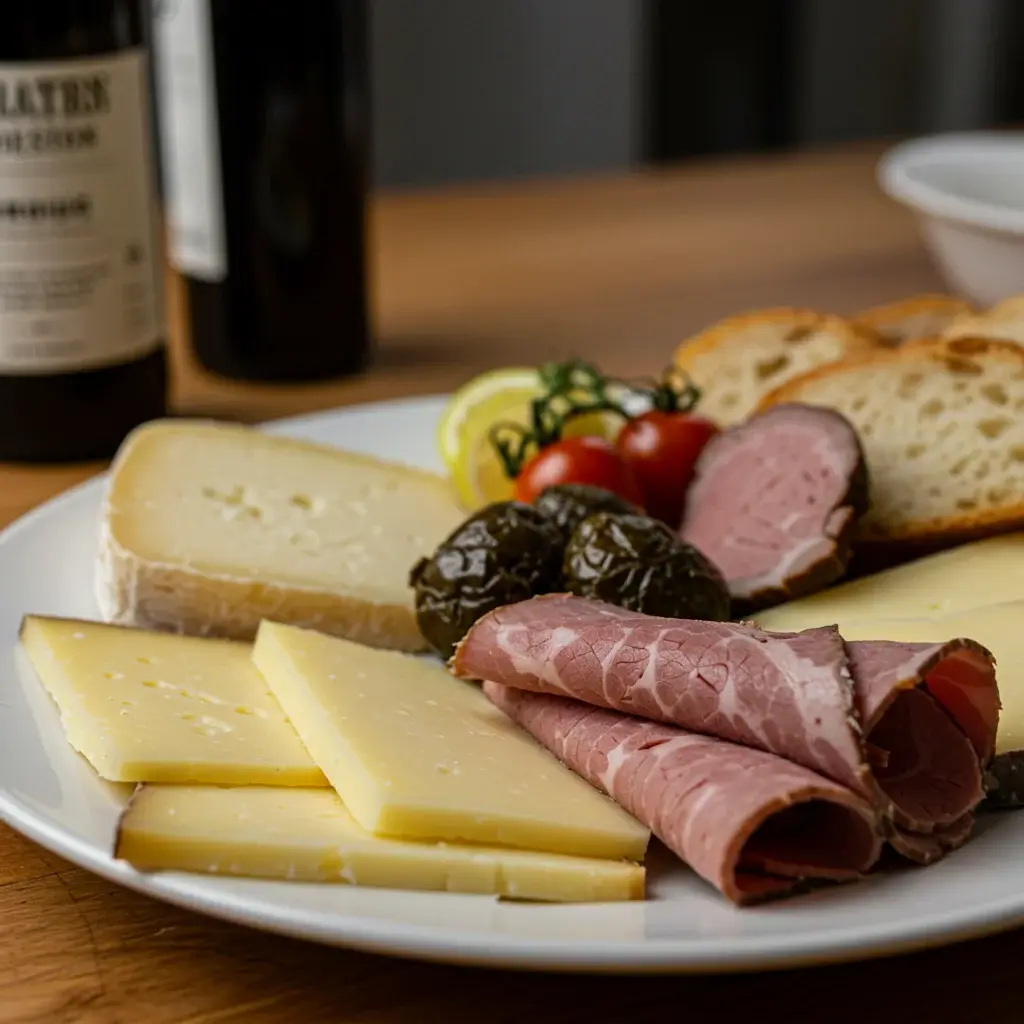A Hearty Ploughman’s Platter Spread is a delightful culinary experience that brings together the rustic flavors of cheese, beef, and bread in a way that is both satisfying and visually appealing. This classic spread is perfect for those who love to indulge in a wholesome and hearty meal. In this article, we will delve into the details of creating a Ploughman’s Platter, exploring its ingredients, preparation steps, nutritional benefits, serving suggestions, and more. Whether you’re planning a cozy dinner for two or a festive gathering, this guide will ensure your platter is a resounding success.
Introduction
The Ploughman’s Platter has its roots in British culinary tradition, often associated with the simple yet fulfilling meals enjoyed by hardworking ploughmen in the fields. This rustic feast typically includes a variety of cheeses, cold meats, crusty bread, pickles, and chutneys, all arranged beautifully on a platter. The combination of flavors and textures creates a satisfying meal that appeals to the senses.
In today’s fast-paced world, the Ploughman’s Platter offers a refreshing return to simplicity and wholesome eating. It is not only a feast for the taste buds but also a visually stunning centerpiece for any dining occasion. Whether you’re a seasoned chef or a novice cook, this guide will provide you with all the information you need to create an authentic and delicious Ploughman’s Platter.
Ingredients
To create a traditional Ploughman’s Platter, you will need the following ingredients:
- Cheeses:
- Mature Cheddar
- Stilton
- Red Leicester
- Cold Meats:
- Sliced roast beef
- Smoked ham
- Salami
- Bread:
- Crusty baguette
- Sourdough loaf
- Rye bread
- Accompaniments:
- Pickled onions
- Branston pickle
- Chutney (mango or apple)
- Cherry tomatoes
- Cucumber slices
- Apple slices
- Condiments:
- Mustard
- Butter
- Optional Add-ons:
- Hard-boiled eggs
- Mixed olives
- Carrot sticks
Instructions
Creating a Ploughman’s Platter is an art that involves arranging a variety of ingredients in an aesthetically pleasing manner. Follow these steps to assemble your platter:
- Prepare the Ingredients:
- Slice the cheeses into wedges or cubes.
- Thinly slice the roast beef, ham, and salami.
- Cut the bread into thick slices.
- Prepare the accompaniments such as pickled onions, cherry tomatoes, cucumber, and apple slices.
- Arrange the Platter:
- Place the cheeses in different sections of the platter, ensuring they are evenly spaced.
- Arrange the cold meats alongside the cheeses, creating a balance of colors and textures.
- Fill the remaining spaces with slices of bread, ensuring they are easily accessible.
- Add the accompaniments and condiments, distributing them evenly around the platter.
- Add the Finishing Touches:
- Garnish the platter with fresh herbs like parsley or rosemary for added color.
- Place small bowls of mustard and chutney on the platter for dipping.
- Optionally, include hard-boiled eggs, olives, and carrot sticks for added variety.
- Serve and Enjoy:
- Allow the platter to come to room temperature before serving to enhance the flavors.
- Provide small plates and forks for guests to help themselves.
Nutrition Facts
The Ploughman’s Platter is a balanced meal that offers a variety of nutrients. Here’s a breakdown of the nutritional content:
- Cheese: High in protein and calcium, cheese is a rich source of essential nutrients. However, it is also high in saturated fats, so moderation is key.
- Beef and Meats: These provide a good source of protein and iron, essential for muscle health and energy.
- Bread: A source of carbohydrates, bread provides the energy needed to power through the day.
- Fruits and Vegetables: Pickles, apples, tomatoes, and cucumbers add vitamins, minerals, and fiber to the platter.
- Condiments: While high in flavor, condiments like chutney and mustard should be used sparingly due to their sugar and sodium content.
The nutritional content will vary based on the specific ingredients used and portion sizes. It’s important to balance the platter with a mix of proteins, carbs, and fresh produce for a wholesome meal.
How to Serve
Serving a Ploughman’s Platter is not just about the food; it’s an opportunity to create a memorable dining experience that reflects your creativity and hospitality. Here’s a comprehensive guide on how to serve this delightful spread in a way that enhances its traditional charm while allowing your guests to fully enjoy the culinary journey.
Presentation
The first step in serving a Ploughman’s Platter is crafting an inviting visual presentation.
- Choose the Right Board: Opt for a large, flat wooden board or a rustic serving platter. The natural texture and warmth of wood add an authentic touch, evoking the countryside origins of the dish. Consider using a charcuterie board that has compartments or sections for different ingredients, which can help keep the presentation organized.
- Arrange with Care: Start by placing the larger items, such as cheese wheels or bread loaves, in the center. Surround these with smaller items, such as pickles, fruits, and spreads. Use different heights for visual interest – for instance, stack some slices of bread or place cheeses on small stands.
- Color and Texture: Include a variety of colors and textures to create an appealing display. Incorporate vibrant fruits like grapes, figs, or apple slices alongside the earthy tones of cheeses and meats. The contrast will make the platter more enticing and mouthwatering.
Accompaniments
To elevate the Ploughman’s Platter, consider pairing it with a thoughtfully selected range of beverages.
- Beverage Choices: Traditional pairings include hearty ales or ciders, which complement the rich flavors of the cheeses and meats. For guests who prefer wine, opt for a light white wine, such as Sauvignon Blanc or a crisp Chardonnay, which can enhance the tasting experience without overpowering the palate.
- Non-Alcoholic Options: Don’t forget guests who may not drink alcohol. Offer refreshing non-alcoholic beverages such as sparkling water infused with citrus or herbal teas, which can provide a sophisticated touch while keeping everyone included in the experience.
Setting
The dining environment plays a crucial role in enhancing the overall experience of enjoying a Ploughman’s Platter.
- Tableware Selection: Choose rustic-themed tableware to complement the platter. Earthenware plates, wooden utensils, and linen napkins can elevate the presentation and create a cohesive aesthetic. Consider using mismatched vintage crockery for an eclectic, homey feel.
- Ambiance: Set the mood with soft lighting, whether it’s through candles, fairy lights, or a well-placed lamp. The warmth of the light will create an inviting atmosphere that encourages guests to linger and enjoy their meal.
- Centerpieces and Decor: A simple floral arrangement or a few sprigs of fresh herbs can serve as a lovely centerpiece without overwhelming the table. Consider using elements from nature, such as small stones or greenery, to enhance the rustic theme.
Sharing Style
The essence of a Ploughman’s Platter lies in its communal nature, allowing guests to share and explore various flavors at their own pace.
- Encourage Interaction: Position the platter at the center of the table and invite guests to serve themselves. Provide serving utensils for each item to keep things hygienic and encourage guests to mix and match ingredients as they build their own combinations.
- Engage Your Guests: Share stories about the ingredients, such as where the cheese was sourced or the origins of the bread. This interaction not only enhances the dining experience but also fosters conversations and connections among guests.
- Create a Relaxed Atmosphere: Encourage a leisurely pace, allowing guests to savor each bite and engage with each other. This relaxed dining style enhances the enjoyment of the Ploughman’s Platter, making it a delightful experience rather than a rushed meal.
By thoughtfully considering presentation, accompaniments, setting, and sharing style, you can create a Ploughman’s Platter experience that is not only delicious but also memorable and enjoyable for all your guests. Embrace the tradition while infusing it with your personal touch, and watch as your dining table becomes a gathering place for laughter, conversation, and shared appreciation of good food.
Additional Tips
To truly elevate your Ploughman’s Platter and create a memorable dining experience, consider the following comprehensive tips that enhance both the visual appeal and the taste of your spread:
Cheese Selection
The cornerstone of any Ploughman’s Platter is, undoubtedly, the cheese. To create a well-rounded selection, aim for a variety of cheeses that differ not only in texture but also in flavor profiles. Here are some detailed suggestions on cheese selection:
- Hard Cheeses: Opt for classic choices like aged Cheddar or Gruyère. These cheeses have a firm texture and a nutty flavor that can stand up to the other components of the platter. Consider including a smoked variant for an additional depth of flavor.
- Soft Cheeses: Creamy cheeses such as Brie or Camembert add a luxurious texture and rich taste. Their mild flavors contrast beautifully with stronger cheeses and can be spread easily onto bread or crackers.
- Blue Cheeses: Incorporating a blue cheese like Roquefort or Gorgonzola introduces a bold flavor that can be polarizing, yet appealing. The tangy and pungent notes of blue cheese can complement sweet elements, such as fruits or honey, perfectly.
- Local and Artisan Cheeses: Explore local cheesemakers for unique offerings. Artisan cheeses often reflect the terroir and can bring a sense of place to your platter. Don’t hesitate to ask for recommendations at your local cheese shop, as they can provide samples to help you choose the best options.
Seasonal Produce
Incorporating seasonal fruits and vegetables not only enhances the flavor of your platter but also adds a burst of color and freshness. Here’s how to select and arrange seasonal produce:
- Fruits: Choose fruits that complement the cheeses and other elements of your platter. For example, slices of crisp apples or pears provide a juicy crunch that pairs well with hard cheeses, while ripe figs or seasonal berries add a touch of sweetness that works harmoniously with blue cheeses. Dried fruits, such as apricots or cranberries, can also offer a chewy texture and concentrated sweetness.
- Vegetables: Fresh vegetables can provide a satisfying crunch and vibrant colors. Consider including items like radishes, cherry tomatoes, and cucumber slices. Roasted or pickled vegetables, such as asparagus or carrots, can add additional layers of flavor and texture.
- Presentation: Arrange the produce creatively on the platter. Use different heights and colors to create an inviting look. Grouping items in small clusters can encourage grazing and make it easy for guests to sample various combinations.
Homemade Touch
Adding a personal touch with homemade condiments can significantly enhance the overall experience of your Ploughman’s Platter. Here are some ideas:
- Pickles: Crafting your own pickles allows you to control the flavors and spices used. Consider quick pickling cucumbers, red onions, or even carrots with vinegar, sugar, and spices for a tangy crunch that balances the richness of the cheeses.
- Chutney: A fruit-based chutney made from seasonal ingredients can offer a delightful contrast to savory cheeses. For example, a tangy apple and onion chutney pairs beautifully with Cheddar, while a spicy mango chutney complements blue cheese. Homemade chutneys often have a fresher taste compared to store-bought versions.
- Spreads: Consider including a homemade spread, such as hummus or a savory tapenade. These can serve as an excellent dip for bread or crackers and can be flavored with herbs or spices to elevate the experience further.
Dietary Preferences
With the growing awareness of dietary restrictions, accommodating various preferences can make your Ploughman’s Platter more inclusive. Here are ways to thoughtfully consider dietary needs:
- Gluten-Free Options: Offer gluten-free bread or crackers to ensure that those with gluten sensitivities can enjoy the platter. Many artisanal bakeries now provide excellent gluten-free options that do not compromise on taste or texture.
- Vegan Proteins: If you have vegan guests, consider adding plant-based cheeses made from nuts or tofu, as well as hearty dips like baba ganoush or roasted red pepper spread. Including an assortment of nuts and seeds can provide protein and crunch.
- Labeling: Clearly label all items on the platter, especially those that cater to specific dietary needs. This not only shows consideration but also helps guests make informed choices.
- Balance and Variety: Ensure that there is a good balance of flavors—salty, sweet, tangy, and spicy—while providing a variety of textures. This approach not only makes the platter visually appealing but also creates an enjoyable tasting experience for everyone.
By thoughtfully curating your Ploughman’s Platter with these tips, you will not only impress your guests but also create a delightful and inclusive culinary experience that highlights the best of seasonal produce and artisanal craftsmanship.
FAQs
What is a Ploughman’s Platter?
A Ploughman’s Platter is a traditional British meal consisting of cheese, cold meats, bread, and accompaniments such as pickles and chutneys. It is often served as a light lunch or dinner.
Can I customize the Ploughman’s Platter?
Absolutely! One of the joys of the Ploughman’s Platter is its versatility. Feel free to customize the ingredients based on personal preference or dietary needs.
How far in advance can I prepare the platter?
You can prepare the platter a few hours in advance. Cover it with plastic wrap and refrigerate. Allow it to come to room temperature before serving.
What drinks pair well with a Ploughman’s Platter?
Traditional pairings include ale, cider, or a light white wine. For a non-alcoholic option, try sparkling water with a slice of lemon.
Conclusion
The Hearty Ploughman’s Platter Spread is more than just a meal; it’s a celebration of rustic flavors and simple pleasures. With its delightful combination of cheese, beef, and bread, complemented by an array of pickles and chutneys, this platter offers a satisfying and wholesome dining experience. Whether enjoyed as a casual lunch or a festive gathering, the Ploughman’s Platter is a testament to the art of simple, yet delicious, eating. By following this guide, you can create a memorable spread that will delight your guests and transport them to the idyllic countryside of Britain.
Print
Hearty Ploughman’s Platter Spread
Ingredients
To create a traditional Ploughman’s Platter, you will need the following ingredients:
- Cheeses:
- Mature Cheddar
- Stilton
- Red Leicester
- Cold Meats:
- Sliced roast beef
- Smoked ham
- Salami
- Bread:
- Crusty baguette
- Sourdough loaf
- Rye bread
- Accompaniments:
- Pickled onions
- Branston pickle
- Chutney (mango or apple)
- Cherry tomatoes
- Cucumber slices
- Apple slices
- Condiments:
- Mustard
- Butter
- Optional Add-ons:
- Hard-boiled eggs
- Mixed olives
- Carrot sticks
Instructions
Creating a Ploughman’s Platter is an art that involves arranging a variety of ingredients in an aesthetically pleasing manner. Follow these steps to assemble your platter:
- Prepare the Ingredients:
- Slice the cheeses into wedges or cubes.
- Thinly slice the roast beef, ham, and salami.
- Cut the bread into thick slices.
- Prepare the accompaniments such as pickled onions, cherry tomatoes, cucumber, and apple slices.
- Arrange the Platter:
- Place the cheeses in different sections of the platter, ensuring they are evenly spaced.
- Arrange the cold meats alongside the cheeses, creating a balance of colors and textures.
- Fill the remaining spaces with slices of bread, ensuring they are easily accessible.
- Add the accompaniments and condiments, distributing them evenly around the platter.
- Add the Finishing Touches:
- Garnish the platter with fresh herbs like parsley or rosemary for added color.
- Place small bowls of mustard and chutney on the platter for dipping.
- Optionally, include hard-boiled eggs, olives, and carrot sticks for added variety.
- Serve and Enjoy:
- Allow the platter to come to room temperature before serving to enhance the flavors.
- Provide small plates and forks for guests to help themselves.
Nutrition
- Serving Size: one normal portion






